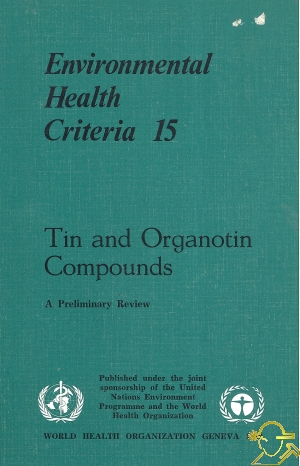Environmental Health Criteria 15
İÇİNDEKİLERTIN AND ORGANOTIN COMPOUNDS: A PRELIMINARY REVIEW1. SUMMARY AND RECOMMENDATIONS FOR FURTHER RESEARCH 1.1 Chemistry and uses of tin compounds 1.1.1 Inorganic tin 1.1.2 Organotin compounds 1.2 Analytical methods 1.3 Environmental concentrations and exposures 1.3.1 Environmental exposures 1.3.2 Occupational exposure 1.4 Metabolism 1.4.1 Inorganic tin 1.4.2 Organotin compounds 1.5 Effects on experimental animals 1.5.1 Inorganic tin 1.5.1.1 Local effects 1.5.1.2 Systemic effects 1.5.2 Organotin compounds 1.5.2.1 Local effects 1.5.2.2 Systemic effects 1.6 Effects in man 1.6.1 Inorganic tin 1.6.2 Organotin compounds 1.6.2.1 Local effects 1.6.2.2 Systemic effects 1.7 Recommendations for further studies 1.7.1 Analytical methods 1.7.2 Environmental data 1.7.3 Metabolism 1.7.4 Effects 2. CHEMISTRY AND ANALYTICAL METHODS 2.1 Elemental tin 2.2 Tin(II) compounds 2.3 Tin(IV) compounds 2.4 Organometallic compounds of tin 2.5 Analytical methods 2.5.1 Determination of inorganic tin 2.5.1.1 Atomic absorption spectrocopy 2.5.1.2 Emission spectroscopy 2.5.1.3 Neutron activation analysis 2.5.1.4 X-ray fluorescence 2.5.1.5 Miscellaneous analytical methods 2.5.2 Determination of organotin compounds 2.5.2.1 Diorganotin compounds 2.5.2.2 Triorganotin compounds 3. SOURCES OF ENVIRONMENTAL POLLUTION 3.1 Natural occurrence 3.2 Industrial production 3.3 Tin consumption 3.4 Uses of tin 3.4.1 Tin and inorganic tin compounds 3.4.2 Organotin compounds 3.5 Tin-containing waste 4. ENVIRONMENTAL TRANSPORT AND TRANSFORMATIONS 4.1 Transport and bioconcentration 4.2 Environmental chemistry of tin 4.3 Degradation of organometallic tin compounds 5. ENVIRONMENTAL CONCENTRATIONS AND EXPOSURE 5.1 Ambient air 5.2 Soils and plants 5.3 Water and marine organisms 5.4 Food 5.5 Organotin residues 5.6 Working environment 5.7 Estimate of effective exposure of man through environmental media 6. METABOLISM 6.1 Inorganic tin 6.1.1 Absorption 6.1.2 Distribution 6.1.2.1 Distribution in human tissues and biological fluids 6.1.3 Excretion 6.1.4 Biological half-time 6.2 Organotin compounds 6.2.1 Absorption 6.2.2 Distribution 6.2.3 Excretion 6.2.4 Biotransformation 7. EFFECTS ON ANIMALS 7. Inorganic tin compounds 7.1.1 Effects on the skin 7.1.2 Respiratory system effects 7.1.3 Effects on the gastrointestinal system 7.1.4 Effects on the liver 7.1.5 Effects on the kidney 7.1.6 Effects on the blood-forming organs 7.1.7 Central nervous system effects 7.1.8 Effects on the reproductive system and the fetus 7.1.9 Carcinogenicity and mutagenicity 7.1.10 Other effects 7.1.11 Effective doses and dose rates 7.1.11.1 Lethal doses 7.1.11.2 Minimum effective and no-observed effects doses 7.2 Organotin compounds 7.2.1 Effects on the skin and eyes 7.2.2 Respiratory system effects 7.2.3 Effects on the gastrointestinal system 7.2.4 Effects on the liver and bile duct 7.2.5 Effects on the kidney 7.2.6 Effects on lymphatic tissue and immunological effects 7.2.7 Haematological effects 7.2.8 Central nervous system effects 7.2.9 Effects on reproduction and the fetus 7.2.10 Carcinogenicity 7.2.11 Effects on chromosomes 7.2.12 Other effects 7.2.13 Mechanisms of action 7.2.14 Effective doses and dose rates 7.2.14.1 Lethal doses 7.2.14.2 Minimum effective and no-observed-effect doses 8.EFFECTS ON MAN 8.1 Inorganic tin compounds 8.1.1 Acute poisoning 8.1.2 Prolonged exposure 8.1.2.1 Effects of inhalation 8.1.2.2 Effects of ingestion 8.2Organotin compounds 8.2.1 Local effects 8.2.2 Systemic effects 8.2.2.1 Effects of dermal exposure 8.2.2.2 Effects of inhalation 8.2.2.3 Effects of ingestion 8.3 Treatment of poisoning REFERENCES    |



